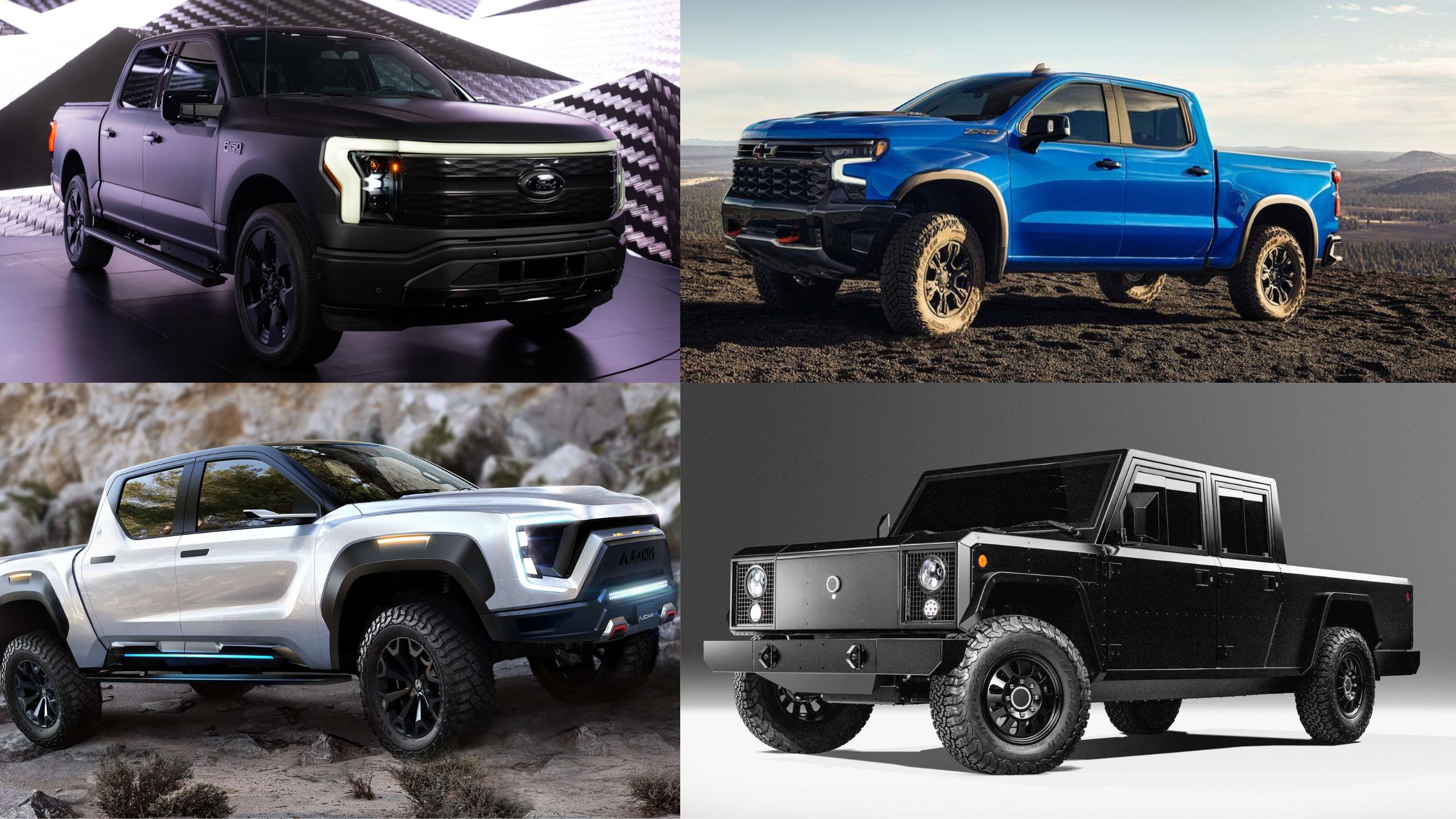The American truck market is experiencing an electrifying revolution as manufacturers race to develop capable electric trucks that can challenge the dominance of traditional combustion-powered workhorses.
These electric trucks promise impressive towing capacity, innovative features, and zero emissions without compromising the utility that made pickup trucks an American icon.
From established automakers to ambitious startups, companies are investing billions to claim their stake in this rapidly evolving segment.
These electric trucks offer instant torque, lower operating costs, and advanced technology features that could reshape how Americans work and play.
While range anxiety, charging infrastructure, and higher upfront costs remain challenges, the capabilities of these electric trucks continue to improve with each generation.
As the market matures and competition intensifies, consumers stand to benefit from more options, better performance, and potentially more affordable entry points.
Here’s a closer look at ten electric trucks vying to become America’s favorite electrified workhorse.
1. Ford F-150 Lightning
The Ford F-150 Lightning represents the electrification of America’s best-selling vehicle for over four decades.
Building on the trusted F-150 platform, Ford has created an electric truck that seamlessly blends familiar utility with forward-thinking innovation.
The Lightning maintains the same dimensions and cargo capacity as its gas-powered sibling while adding capabilities unique to electric vehicles.
Under its hood lies not an engine but a spacious 14.1 cubic foot “frunk” (front trunk) complete with power outlets, making it ideal for storing tools or serving as a mobile workstation.
The Lightning delivers impressive performance specifications with up to 580 horsepower and 775 lb-ft of instant torque in extended-range configurations.
This power translates to a 0-60 mph time of approximately 4.5 seconds, making it quicker than many sports cars despite its utilitarian design.
The Lightning’s capabilities extend beyond speed, with a towing capacity reaching 10,000 pounds and a payload capacity of up to 2,000 pounds.
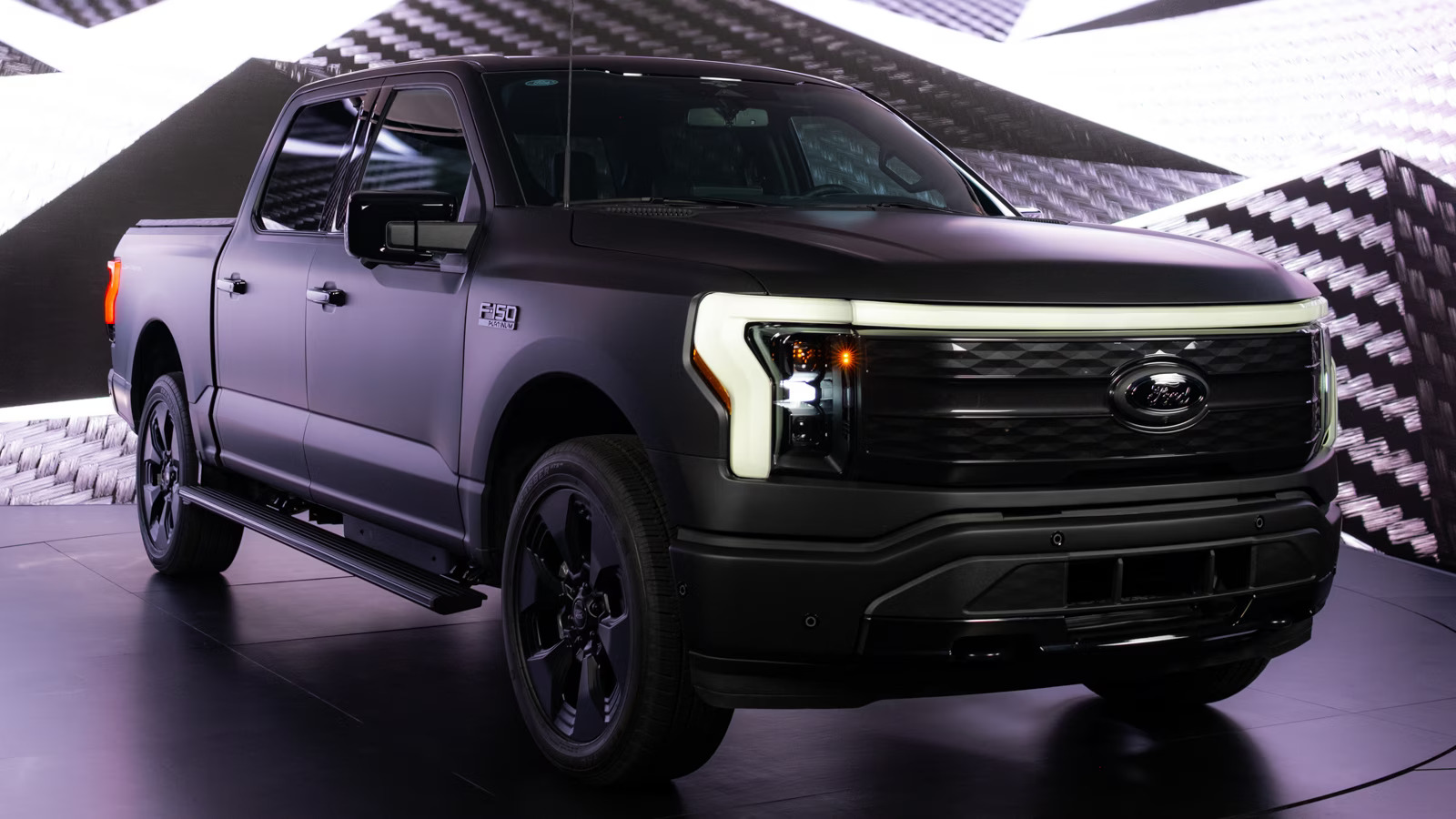
Ford’s Pro Power Onboard system transforms the truck into a mobile generator, offering up to 9.6 kW of power through multiple 120V and 240V outlets enough to power a construction site or a home during outages.
Range varies from approximately 230 miles with the standard battery to 320 miles with the extended-range option. Fast-charging capabilities allow the truck to regain up to 80% charge in about 40 minutes on a 150 kW DC fast charger.
The Lightning also introduces bidirectional charging, enabling owners to power their homes during outages or sell electricity back to the grid during peak demand periods.
Starting at approximately $55,000 (before incentives) for the base Pro model and reaching over $90,000 for fully loaded Platinum versions, the F-150 Lightning strategically positions itself as a practical electric alternative for both work and personal use.
By maintaining the familiar F-150 form factor while adding electric advantages, Ford aims to convert traditional truck enthusiasts to electric ones without forcing them to abandon what they love about pickup trucks.
2. Rivian R1T
The Rivian R1T has established itself as a premium lifestyle electric truck for adventurers and outdoor enthusiasts.
As one of the first electric trucks to reach customers, Rivian has carved out a distinct identity in the market with its blend of luxury, technology, and genuine off-road capability.
The R1T features a unique quad-motor system with an electric motor powering each wheel independently, delivering precise torque vectoring and remarkable off-road performance.
This configuration generates up to 835 horsepower and 908 lb-ft of torque, propelling the truck from 0-60 mph in just 3 seconds.
Despite this supercar-like acceleration, the R1T maintains practical capabilities with an 11,000-pound towing capacity and 1,760-pound payload rating.
Among the R1T’s most innovative features is the “Gear Tunnel,” a horizontal storage compartment running through the truck between the cab and bed.
This 65-inch long space can accommodate anything from golf clubs to surfboards and can be equipped with a slide-out camp kitchen for outdoor cooking.
The truck’s adaptable air suspension allows ground clearance adjustments from 7.9 to 14.9 inches, enabling it to wade through three feet of water.
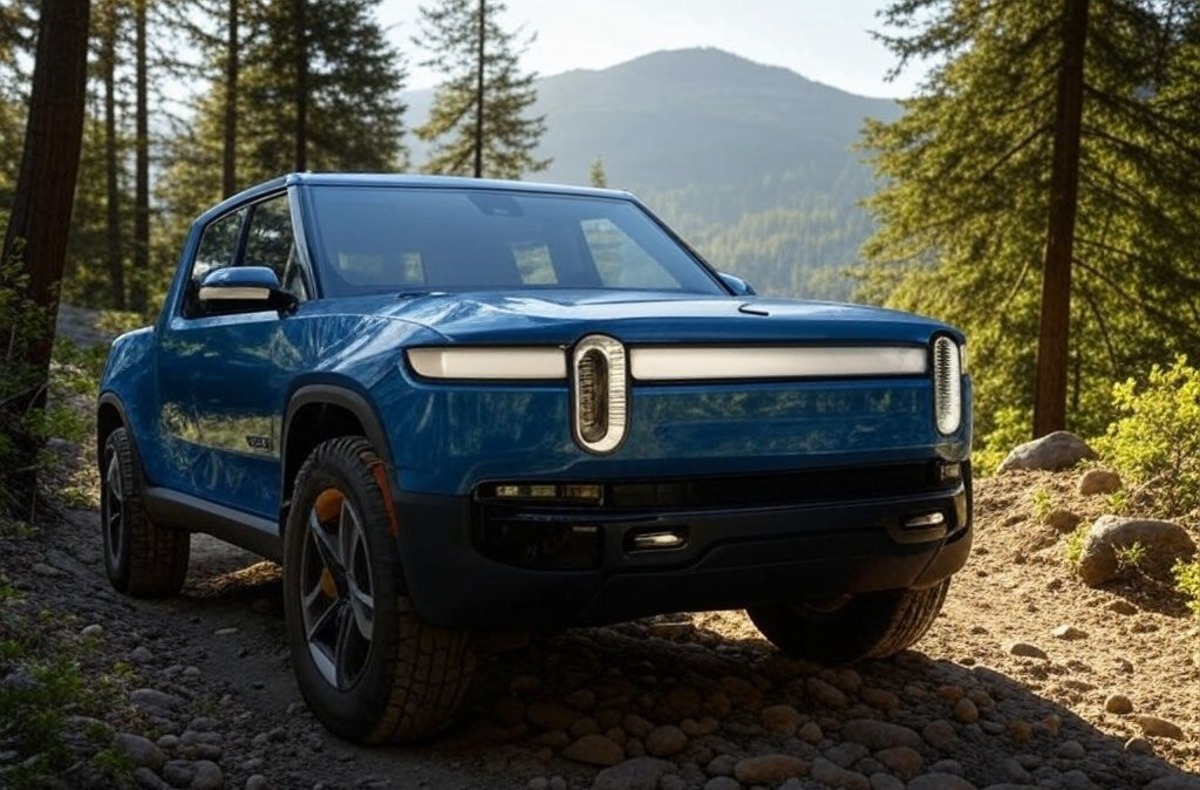
Rivian has emphasized adventure readiness with features like an integrated air compressor for inflating tires after off-roading, a removable Bluetooth speaker, and an optional three-person tent that mounts to the truck bed.
The interior continues this premium adventure theme with sustainably sourced materials, a panoramic glass roof, and two large displays for infotainment and driver information.
Range varies from approximately 270 to 400+ miles depending on battery configuration and chosen wheel/tire package. Rivian continues to expand its proprietary charging network, focusing on adventure destinations often overlooked by other charging providers.
Starting at around $73,000 for dual-motor configurations, the R1T positions itself as a premium product that justifies its price through innovation, performance, and lifestyle alignment.
As Rivian continues to scale production and expand its lineup, the R1T remains the flagship product that established the brand’s reputation for merging luxury with capability in the electric truck segment.
3. Tesla Cybertruck
The Tesla Cybertruck stands as perhaps the most polarizing vehicle of the decade, with its angular stainless steel exoskeleton and sci-fi aesthetic challenging traditional truck design conventions.
Released after numerous delays, the Cybertruck represents Tesla’s ambitious attempt to disrupt the pickup truck market with radical design and engineering approaches.
The Cybertruck’s unconventional appearance stems from its structural exoskeleton made of 30X cold-rolled stainless steel, eliminating the need for traditional body panels and paint.
This ultra-hard material, combined with Tesla armor glass, promises superior durability against dents, damage, and corrosion. The triangular roof design isn’t merely stylistic but provides structural rigidity while maximizing interior space.
Performance varies across three available configurations. The tri-motor “Cyberbeast” variant delivers 845 horsepower, enabling 0-60 mph acceleration in just 2.6 seconds astonishing for a vehicle weighing over 6,800 pounds.
Towing capacity reaches up to 11,000 pounds, with a payload capacity of around 2,500 pounds. The integrated 250 kW charging capability allows rapid recharging on Tesla’s Supercharger network.
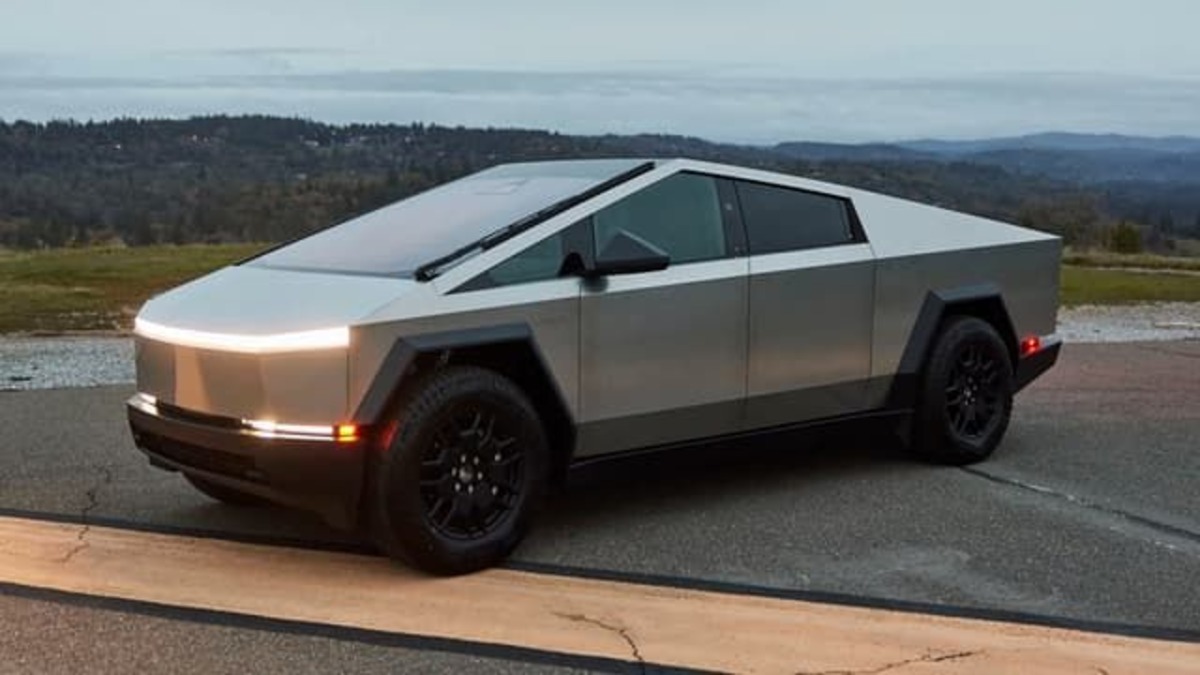
Inside, the Cybertruck continues Tesla’s minimalist interior approach with an 18.5-inch central touchscreen, digital rearview mirror, and distinctive yoke steering wheel.
The 6.5-foot bed features an integrated powered tonneau cover that creates a secure, weatherproof storage vault when closed. Additional innovations include a built-in ramp for loading equipment, an adjustable air suspension that provides up to 16 inches of ground clearance, and Tesla’s acclaimed Autopilot driver assistance features.
Range varies from approximately 250 miles for rear-wheel drive models to over 340 miles for upper trims, with an optional range extender pushing capability beyond 470 miles. Starting prices range from around $61,000 for the base model to $100,000+ for fully-equipped Cyberbeast versions.
Despite production challenges and design compromises from the original concept, the Cybertruck has maintained strong reservation numbers, demonstrating significant consumer interest in its unique approach.
Whether viewed as an engineering triumph or design aberration, the Cybertruck has succeeded in one crucial aspect: forcing the entire industry to reconsider what a pickup truck can be.
4. Chevrolet Silverado EV
The Chevrolet Silverado EV represents General Motors’ comprehensive approach to electrifying one of America’s most popular full-size trucks.
Unlike some competitors that adapted existing platforms, the Silverado EV was designed from the ground up on GM’s advanced Ultium platform, allowing for optimized electric architecture without the compromises of conversion.
The Silverado EV features distinctive styling that balances futuristic elements with recognizable Chevrolet design language.
Its most notable innovation is the Multi-Flex Midgate, which allows the wall between the cab and bed to fold down, extending the bed from 5’11” to over 9 feet while maintaining seating for rear passengers on one side if needed.
Combined with the Multi-Flex Tailgate and available tonneau cover, this creates a secure, weatherproof space for cargo up to 10’10” long.
Performance specifications impress with up to 754 horsepower and 785 lb-ft of torque in the RST trim, enabling 0-60 mph acceleration in less than 4.5 seconds.
The truck offers up to 10,000 pounds of towing capacity and 1,300 pounds of payload. Working professionals will appreciate the available PowerBase charging system, which provides up to 10.2 kW of power through ten outlets, including 120V and 240V options for powering tools, campsites, or even homes.
The Silverado EV offers a segment-leading range with up to 450 miles on a single charge in certain configurations. 350 kW DC fast-charging capability adds approximately 100 miles of range in just 10 minutes.
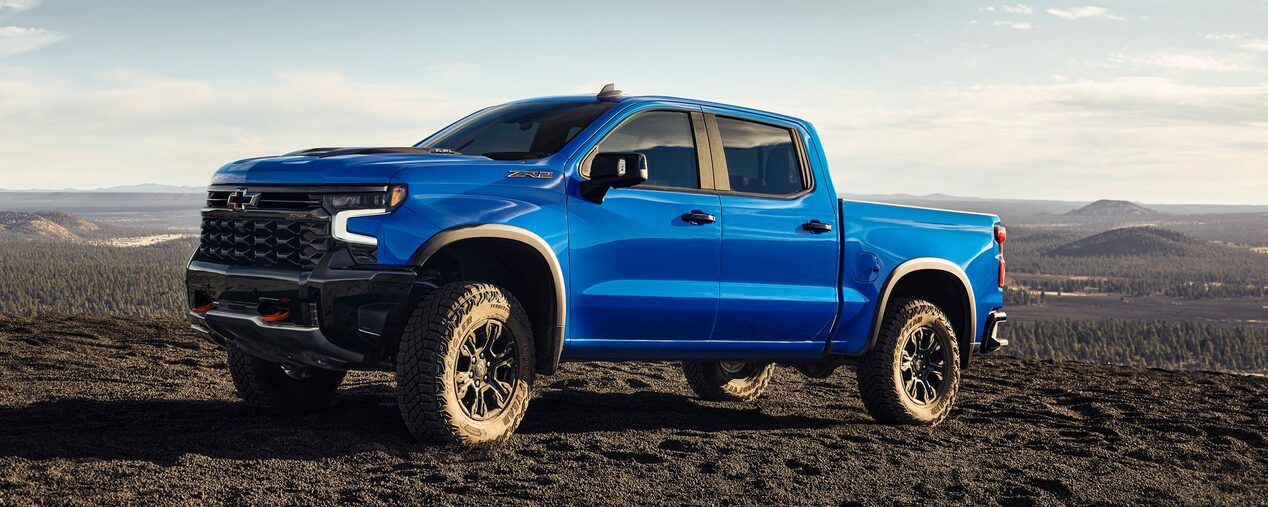
Four-wheel steering and adaptive air suspension improve maneuverability and capability, allowing the truck to operate in spaces typically challenging for vehicles of its size.
Initially launching with the fleet-focused Work Truck (WT) variant starting at around $74,800 and premium RST First Edition at $105,000, Chevrolet plans to expand the lineup with more affordable options starting at around $50,000.
The strategic rollout prioritizes commercial customers while establishing the Silverado EV as a technology showcase before introducing more accessible trims.
With its combination of practical innovations like the Multi-Flex Midgate, impressive range, and purpose-built electric architecture, the Silverado EV demonstrates GM’s commitment to electrifying its most important vehicle segments without compromising the capability truck buyers demand.
Also Read: 12 Exotic Cars That Can Be Surprisingly Practical in the USA
5. GMC Hummer EV Pickup
The GMC Hummer EV Pickup represents the audacious resurrection and reinvention of a controversial brand, transformed from a symbol of excess into a showcase for General Motors’ most advanced electric technology.
This “super truck” approaches electrification not as a compromise but as an opportunity to exceed the capabilities of traditional trucks in nearly every metric.
Built on GM’s Ultium platform, the Hummer EV in its most powerful configuration delivers a staggering 1,000 horsepower and 11,500 lb-ft of wheel torque (equivalent to approximately 1,200 lb-ft at the motor) from its three-motor setup.
This immense power enables the “Watts to Freedom” launch mode, propelling the 9,000+ pound vehicle from 0-60 mph in approximately 3 seconds an almost physics-defying feat for a vehicle of its size.
The Hummer EV’s most distinctive feature is its “CrabWalk” capability, which uses four-wheel steering to allow the truck to move diagonally at low speeds invaluable for going through tight off-road trails or parking in confined spaces.
The adaptive air suspension can raise the vehicle by 6 inches in Extract Mode, providing nearly 16 inches of ground clearance for extreme off-road scenarios.
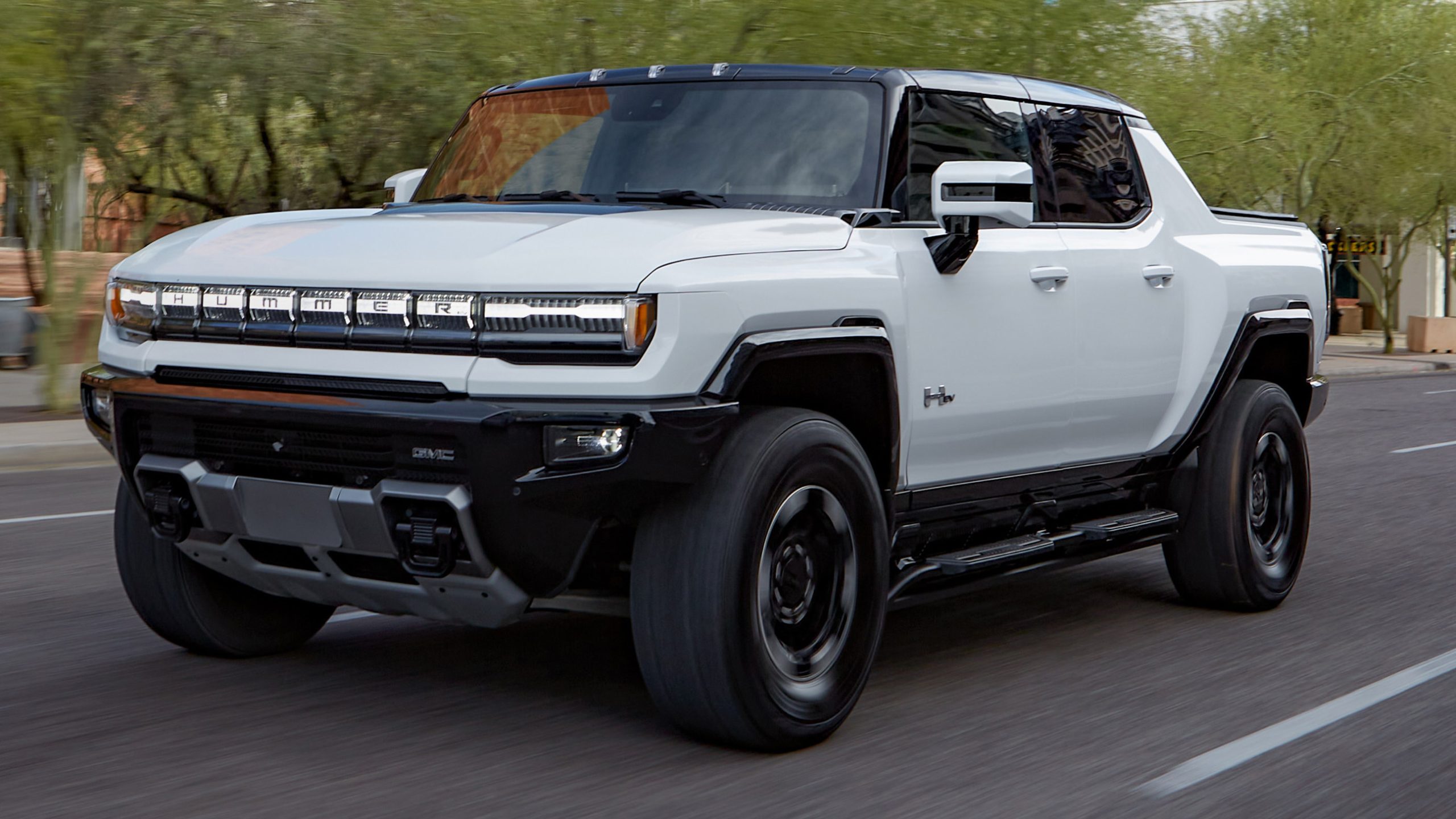
The interior combines rugged utility with premium technology, featuring a 13.4-inch center touchscreen, 12.3-inch digital instrument cluster, and up to 18 camera views including underbody cameras for precise off-road navigation.
The Infinity Roof system includes removable transparent Sky Panels that are stored in the front trunk, transforming the Hummer into an open-air vehicle.
Range extends to approximately 329 miles on Edition 1 models, with 800-volt architecture enabling 350 kW charging that can add up to 100 miles of range in 10 minutes. With 9.6 kW of exportable power, the Hummer can serve as a mobile power station for worksite tools or campsite amenities.
Pricing starts at approximately $80,000 for the base EV2 model (coming in 2025) and exceeds $110,000 for fully-equipped Edition 1 versions.
This positioning establishes the Hummer EV as a halo product showcasing GM’s electric capabilities while targeting wealthy early adopters seeking the ultimate expression of electric capability.
By transferring Hummer’s legacy of dominance from fuel consumption to technological innovation, GMC has created an electric truck that challenges perceptions about what electric vehicles can accomplish in extreme conditions.
6. Ram 1500 REV
The Ram 1500 REV represents Stellantis’ carefully calculated entry into the electric truck segment, designed to appeal to traditional truck buyers while offering advantages unique to electrification.
After observing early market responses to competitors’ offerings, Ram developed a truck that maintains familiar proportions and capabilities while incorporating next-generation electric architecture.
Unlike some competitors that radically reimagined truck design, the Ram 1500 REV maintains visual continuity with its combustion counterpart, featuring refined aerodynamics without sacrificing the muscular stance that defines the brand.
This approach allows Ram to transition its loyal customer base to electrification without alienating them with radical design changes. The REV’s dual-motor powertrain delivers up to 654 horsepower and 620 lb-ft of torque, enabling 0-60 mph acceleration in approximately 4.4 seconds.
More importantly for truck buyers, it maintains a 14,000-pound towing capacity and 2,700-pound payload rating competitive figures that ensure the electric truck can handle serious work responsibilities.
Range anxiety is addressed with two battery options: a standard 168 kWh pack offering approximately 350 miles and an optional 229 kWh “Range Extender” configuration promising up to 500 miles among the longest ranges available in any electric vehicle.
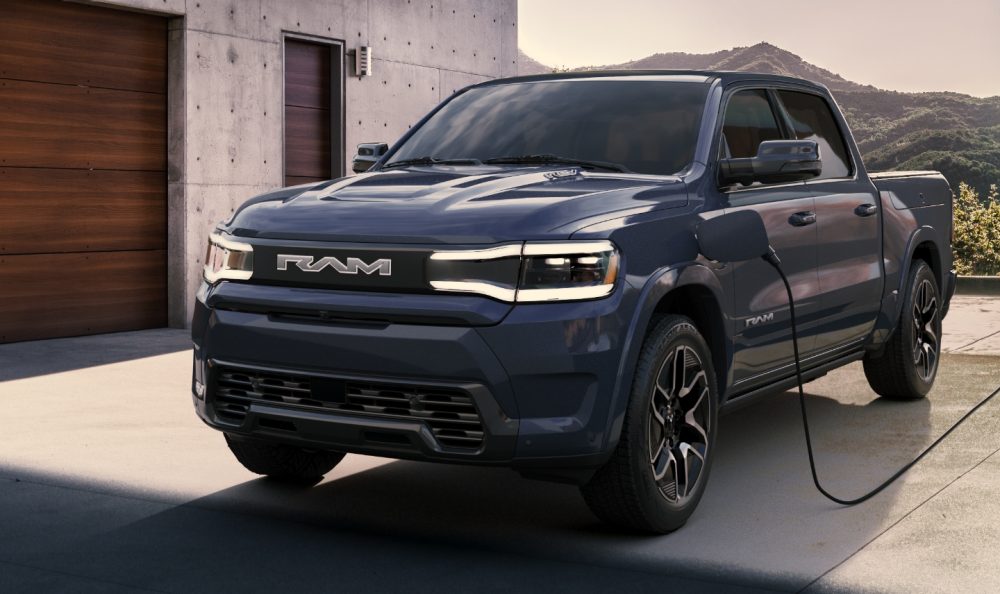
The 800-volt electrical architecture enables charging at up to 350 kW, adding up to 110 miles of range in about 10 minutes when connected to capable DC fast chargers.
Innovative features include a spacious frunk with pass-through capability to the cabin, bidirectional charging with up to 7.2 kW of exportable power, and the RamBox side storage system integrated with the bed design.
Inside, the REV features a 14.5-inch central touchscreen, 12.3-inch digital instrument cluster, and a 10.25-inch passenger display, all powered by the STLA Brain electrical architecture and STLA SmartCockpit software.
Starting at approximately $73,000 for base Tradesman models and reaching $100,000+ for premium Limited variants, the Ram 1500 REV is positioned as a premium offering with pricing reflecting its advanced technology and capability.
Ram’s decision to enter the market later than competitors allowed it to observe early adopter feedback and refine its offering accordingly.
By balancing innovation with familiarity, the Ram 1500 REV aims to convince traditional truck buyers that electric power can enhance rather than compromise the capability that defines American pickup trucks.
7. Lordstown Endurance
The Lordstown Endurance represents one of the most turbulent journeys in the electric truck market, embodying both the promise and challenges of EV startups attempting to break into the automotive industry.
Originally positioned as the first electric truck specifically designed for commercial fleet customers, Endurance faced significant financial and production hurdles that ultimately transformed its market position.
The Endurance’s most distinctive technical feature is its hub motor design, with four individual electric motors located directly in each wheel hub rather than on the axles.
This approach eliminates traditional drivetrain components like drive shafts and differentials, potentially reducing maintenance requirements a significant advantage for fleet operators concerned with a total cost of ownership.
The system delivers approximately 550 horsepower with impressive torque delivery direct to the wheels.
Designed specifically for commercial work applications, the Endurance features a conventional truck profile with a practical interior focused on durability rather than luxury.
Its 109 kWh battery pack provides a range of approximately 200 miles sufficient for many daily commercial routes while keeping costs and weight lower than longer-range competitors.
Towing capacity reaches 8,000 pounds with a payload rating of 1,500 pounds, meeting the needs of many commercial applications.
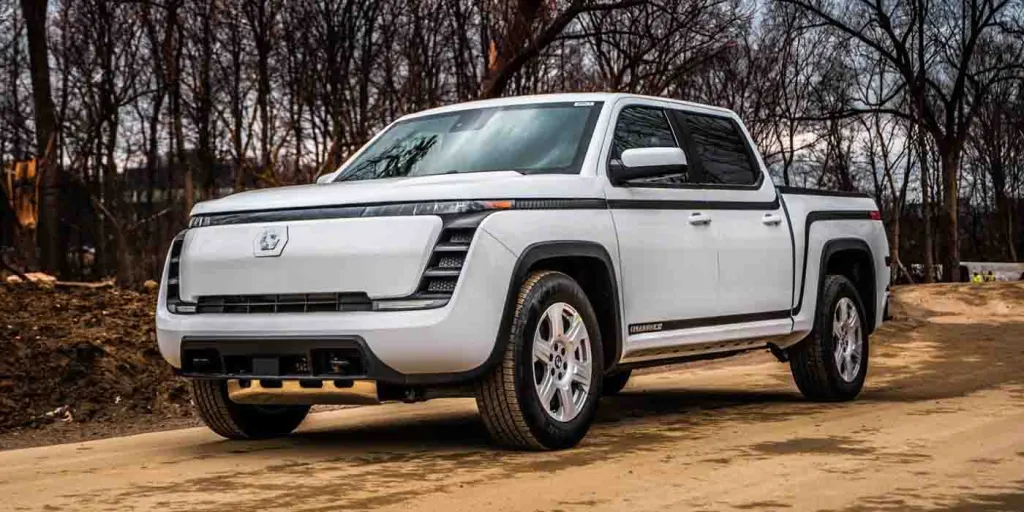
After significant financial challenges, production rights for the Endurance were acquired by Foxconn, the Taiwanese manufacturing giant seeking to expand into automotive production.
This partnership shifted the truck’s market position from a standalone product to part of a broader electric commercial vehicle strategy. Limited production began with priority for fleet customers who placed early reservations.
Starting at approximately $65,000 before incentives, the Endurance occupies a specialized niche focusing on commercial fleet applications rather than competing directly with consumer-oriented electric trucks.
Its value proposition centers on reduced maintenance costs through its hub motor design and simplified ownership experience for fleet managers.
The Endurance’s journey illustrates the significant challenges facing automotive startups in scaling production, particularly during a period of supply chain disruptions and economic uncertainty.
Despite these obstacles, the truck’s focus on practical commercial applications rather than premium features represents an important approach to electric truck adoption focused on total cost of ownership rather than cutting-edge technology.
8. Nikola Badger
The Nikola Badger represents one of the most complex and controversial chapters in the emerging electric truck market a vehicle announced with substantial fanfare but ultimately never reaching production in its originally conceived form.
Despite its unrealized status, the Badger remains significant for its ambitious technical specifications and the broader lessons it offers about the challenges of automotive startups.
Initially revealed in 2020, the Badger was promoted as a revolutionary pickup combining battery-electric and hydrogen fuel cell technologies in a “best of both worlds” approach.
This hybrid powertrain promised up to 300 miles of battery range plus an additional 300 miles from hydrogen fuel cells, potentially addressing range anxiety while offering rapid refueling capabilities.
The announced specifications were impressive: 906 horsepower, 980 lb-ft of torque, 8,000 pounds of towing capacity, and acceleration from 0-60 mph in approximately 2.9 seconds.
The Badger’s design featured aggressive styling with distinctive LED lighting elements and a multifunctional tailgate system. The interior promised advanced technology with a large central touchscreen, a digital instrument cluster, and innovative storage solutions.
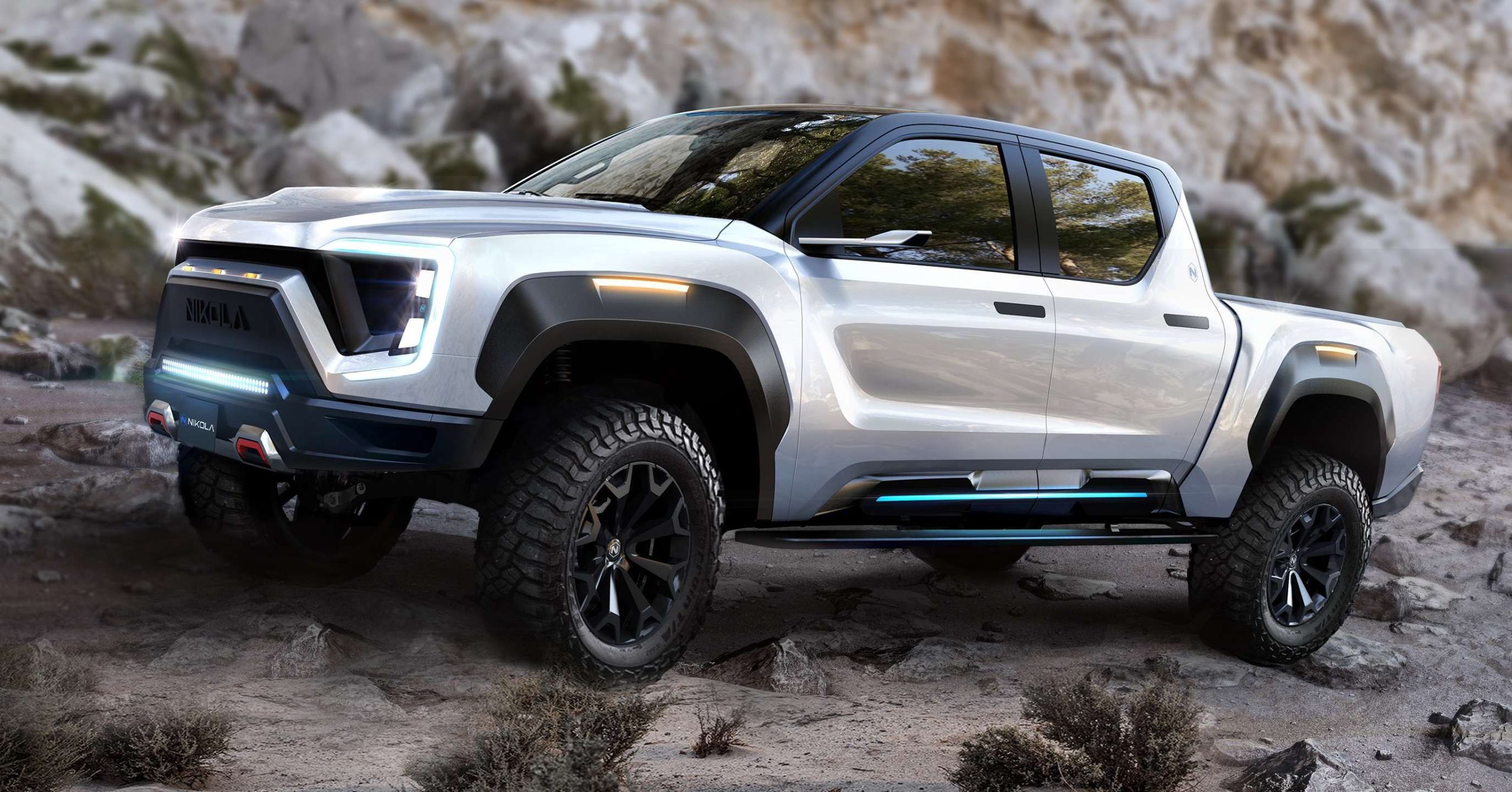
Perhaps most uniquely, Nikola announced the truck would include a built-in water fountain supplied by the fuel cell’s only emission: pure water.
The Badger’s story took a dramatic turn when Nikola announced a partnership with General Motors in September 2020, which would have seen GM manufacturing the Badger using its Ultium battery technology and Hydrotec fuel cell system.
However, following allegations regarding misrepresentation of Nikola’s technology capabilities, this partnership was substantially scaled back and the Badger program was canceled entirely.
The Badger’s journey from announcement to cancellation illustrates several critical challenges facing automotive startups: the enormous capital requirements for vehicle development, the complexity of scaling production, and the heightened scrutiny facing companies making ambitious technological claims.
While never reaching customers, the Badger contributed to broader industry conversations about alternative powertrain approaches and the challenges of bringing revolutionary vehicles to market.
After restructuring, Nikola has refocused its efforts on commercial hydrogen fuel cell trucks rather than consumer vehicles, demonstrating how market realities often reshape ambitious business plans. The Badger remains a fascinating “what might have been” chapter in the electric truck narrative.
9. Canoo Pickup Truck
The Canoo Pickup Truck represents one of the most unconventional approaches to electric truck design, emphasizing modularity, space efficiency, and urban utility over traditional truck aesthetics and capabilities.
Emerging from a technology-focused startup with roots in the EV industry, Canoo’s truck reimagines what a pickup could be when freed from internal combustion constraints.
The most striking aspect of Canoo’s pickup is its “cab-forward” design, which maximizes interior space by positioning the driver directly above the front wheels in a configuration impossible with traditional engine compartments.
This approach creates a vehicle with the footprint of a mid-size truck but an interior volume closer to a full-size model. The distinctive bubble-shaped cab features panoramic glass and a minimalist interior focused on functionality rather than a luxury.
The truck’s bed measures a conventional 6 feet in length but incorporates a pull-out extension that reaches 8 feet when deployed accommodating standard construction materials.
Innovative features include multiple power outlets, integrated side steps that double as storage compartments, fold-down work tables, and a modular divider system that can segment the bed for different cargo needs.
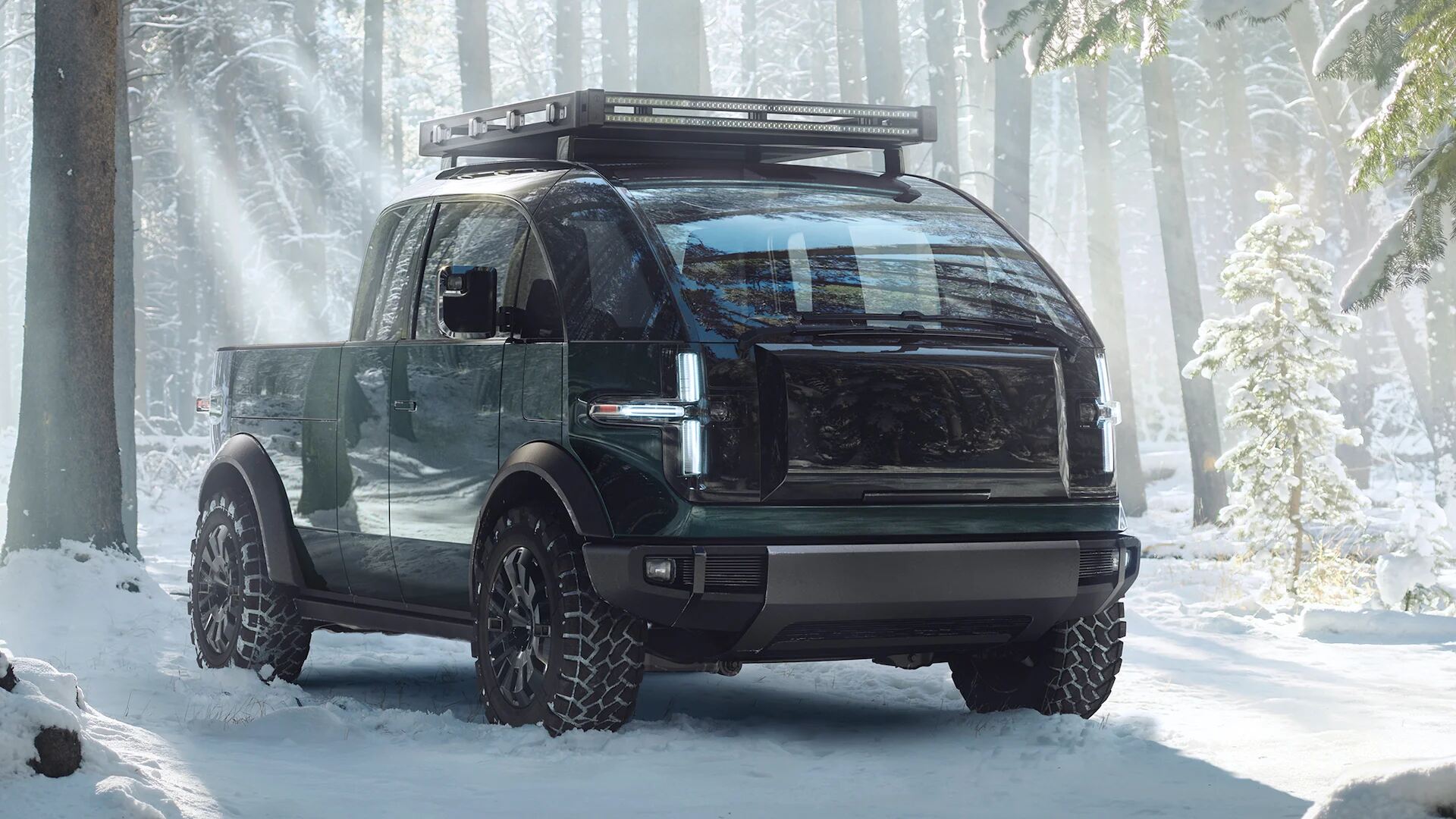
The front cargo area (“frunk”) is accessible from the side rather than the top, improving ergonomics for loading and unloading. Performance specifications include up to 600 horsepower from dual motors, providing all-wheel drive capability.
Range is estimated at approximately 200 miles from an 80 kWh battery pack sufficient for urban and suburban use cases but less than long-haul competitors. Towing capacity reaches 2,000 pounds, positioning the vehicle for light-duty applications rather than heavy work tasks.
Following financial challenges and leadership changes, Canoo has pivoted from its original direct-to-consumer model toward fleet sales and government contracts, securing deals with several notable clients including NASA. Production plans have been adjusted accordingly, with pricing expected around $35,000 for base models when full production begins.
The Canoo Pickup represents an important alternative vision for electric trucks one focused on urban utility, innovative space utilization, and modular functionality rather than maximizing traditional truck metrics like towing and payload.
By reimagining what a pickup truck can be rather than electrifying existing formats, Canoo demonstrates how vehicle architecture can evolve when freed from internal combustion constraints.
10. Bollinger B2
The Bollinger B2 stands as perhaps the most utilitarian and purpose-built electric truck concept, eschewing luxury and technology features to focus on pure functionality with an almost military-grade aesthetic.
Founded by Robert Bollinger to create the ultimate utilitarian electric vehicles, Bollinger Motors developed a distinctive approach that prioritized capability over comfort.
The B2’s design is instantly recognizable for its boxy, minimalist appearance reminiscent of vintage off-road vehicles. With sharp angles, exposed rivets, and aluminum body panels, the truck projects rugged durability rather than aerodynamic efficiency.
This form-follows-function philosophy extends to features like removable doors, windows, windshields, and roof panels, allowing the truck to be configured for different work environments.
The B2’s most innovative feature is its patented pass-through system a continuous tunnel running from the front trunk through the cabin to the truck bed, allowing for transportation of items up to 16 feet long despite the truck’s relatively compact dimensions.
Combined with the fold-down front and rear seats, this creates extraordinary cargo flexibility for a vehicle of its size. Technical specifications include dual motors delivering 614 horsepower and 668 lb-ft of torque, enabling surprising performance for such a utilitarian vehicle.
The hydropneumatic suspension offers adjustable ride height from 10 to 15 inches of ground clearance, with 10 inches of wheel travel facilitating serious off-road capability.
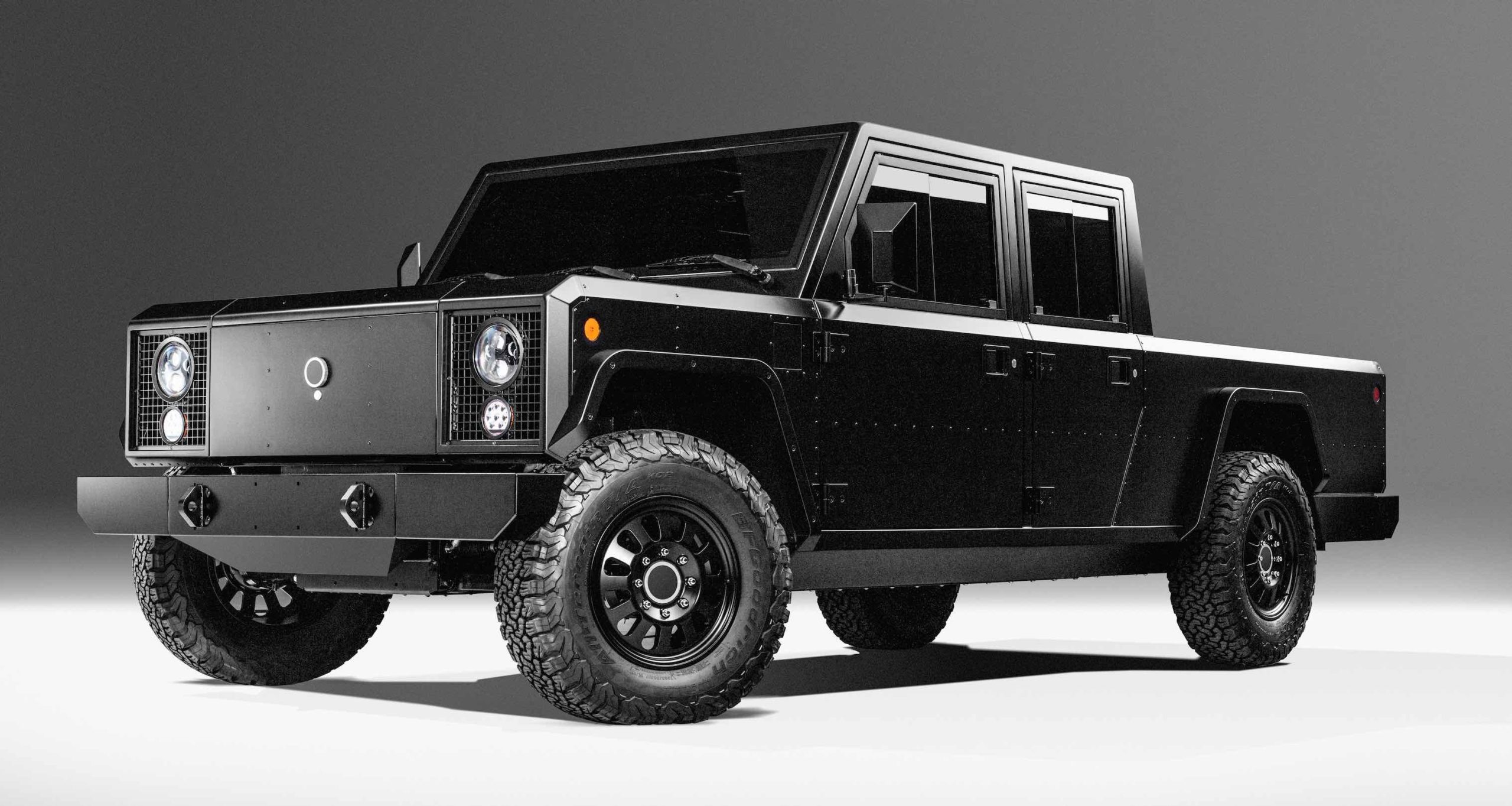
Towing capacity reaches 7,500 pounds with a payload rated at 5,000 pounds exceptional figures that reflect the truck’s work-focused design.
In 2022, Bollinger announced a strategic shift, pausing the development of consumer vehicles including the B2 to focus on commercial electric platforms and chassis cabs for fleet applications.
This pivot reflected both the enormous capital requirements for bringing consumer vehicles to market and the more immediate opportunities in commercial fleet electrification.
Though its consumer production prospects remain uncertain, Bollinger B2 made significant contributions to the electric truck conversation by demonstrating that electric vehicles need not be defined by screens and luxury they can be purpose-built tools designed for serious work applications.
The B2’s influence can be seen in aspects of other manufacturers’ designs, particularly those emphasizing utility over technology features.
Also Read: 10 Luxury SUVs Designed for Business Executives & Top Professionals

